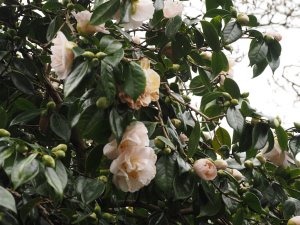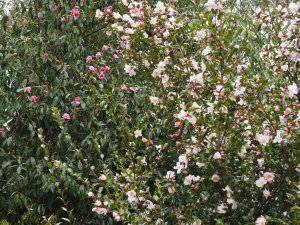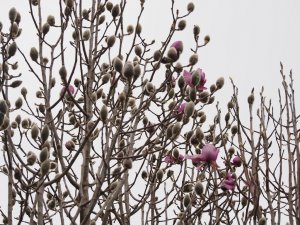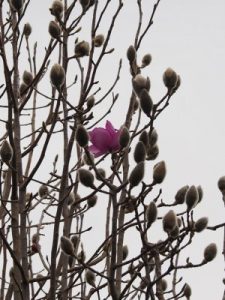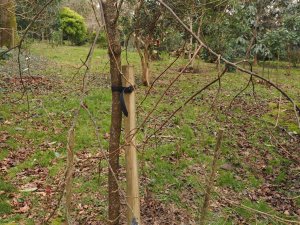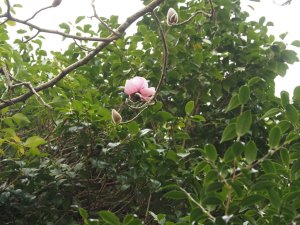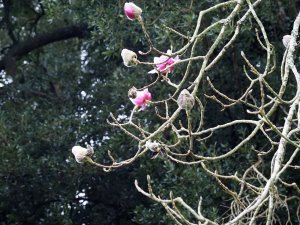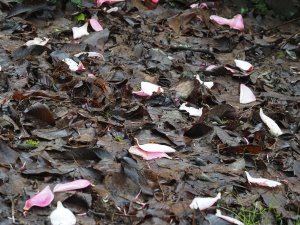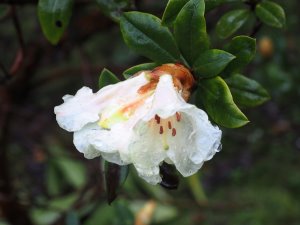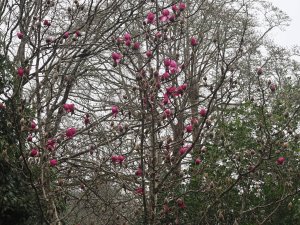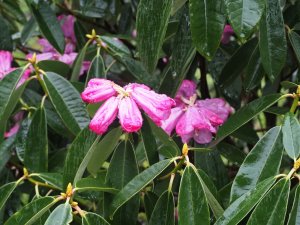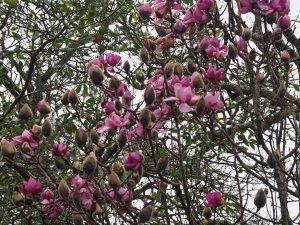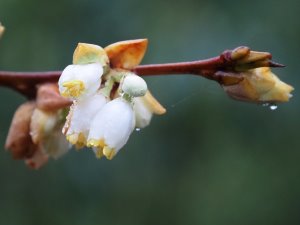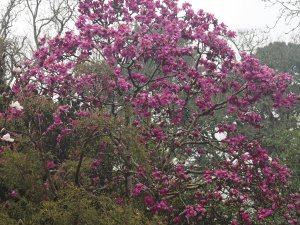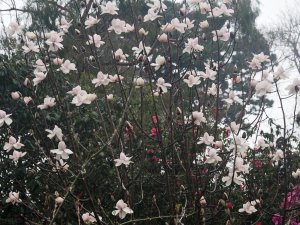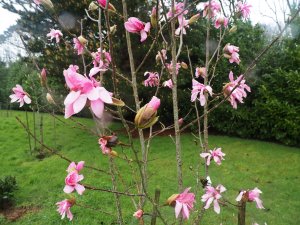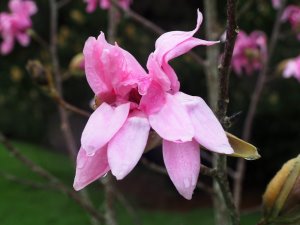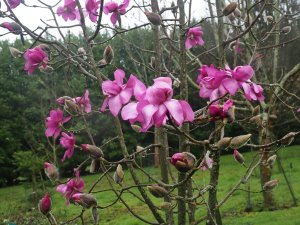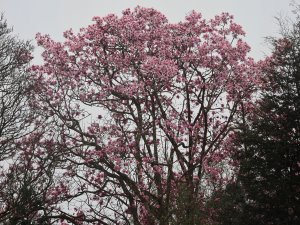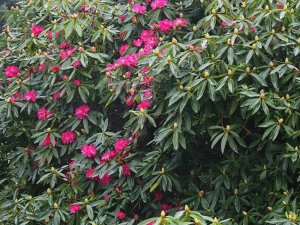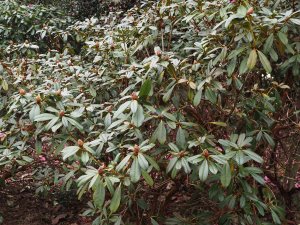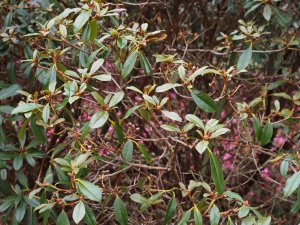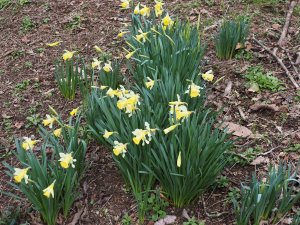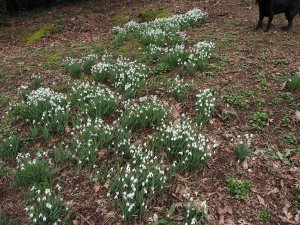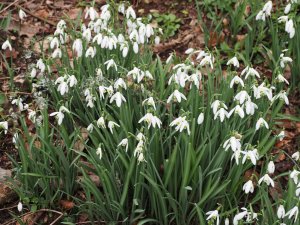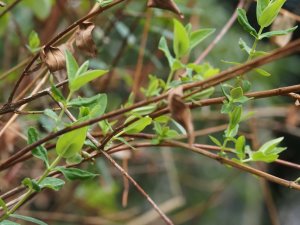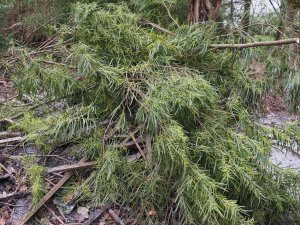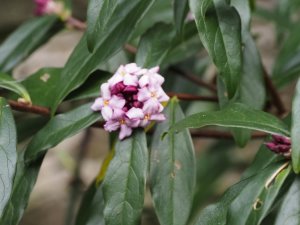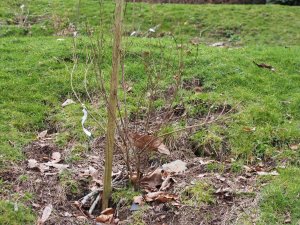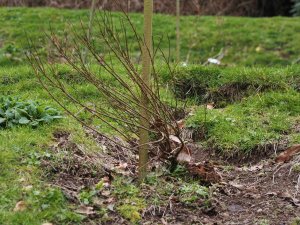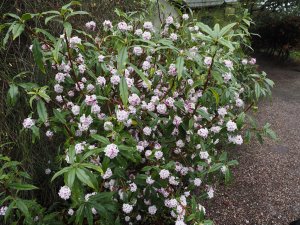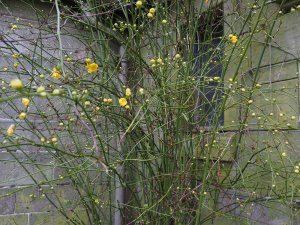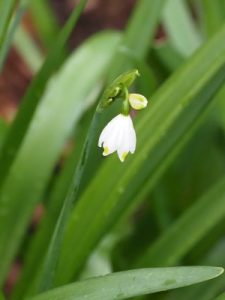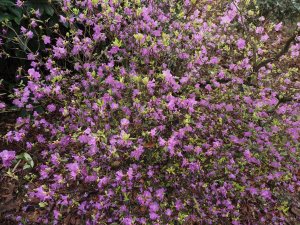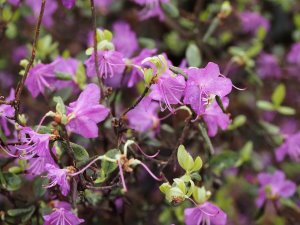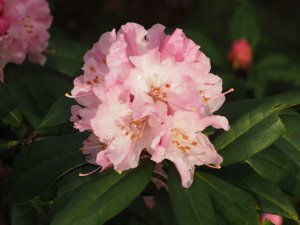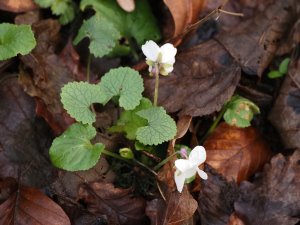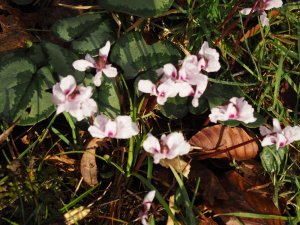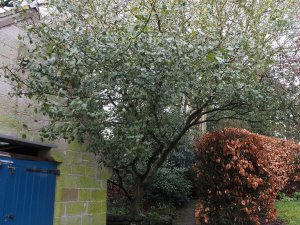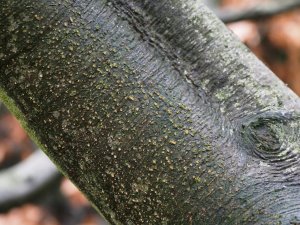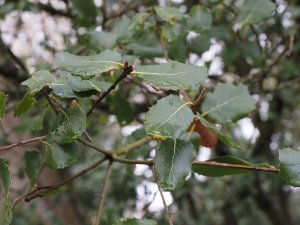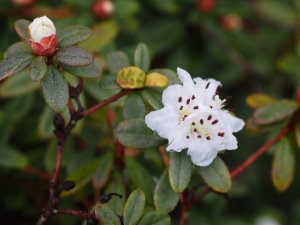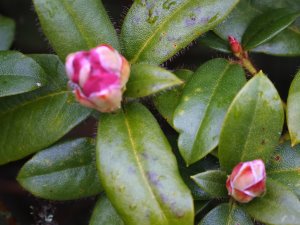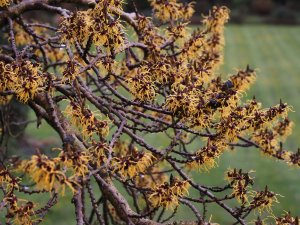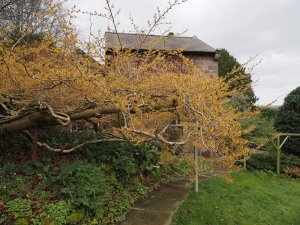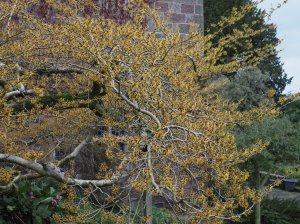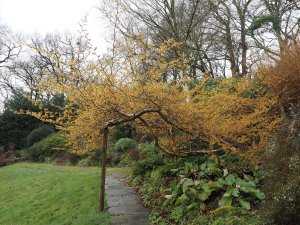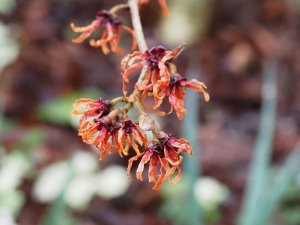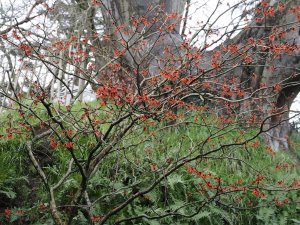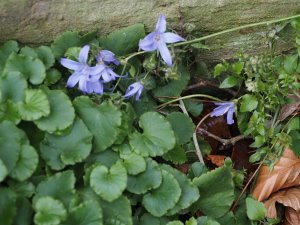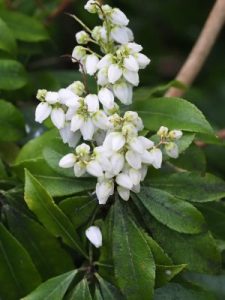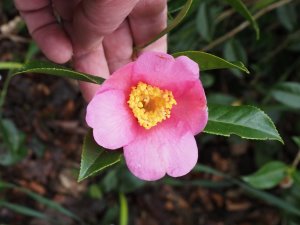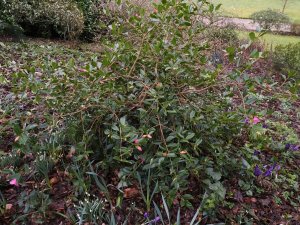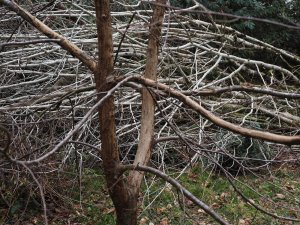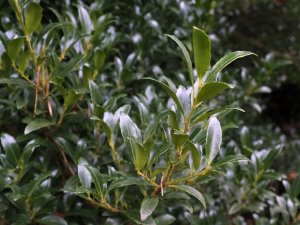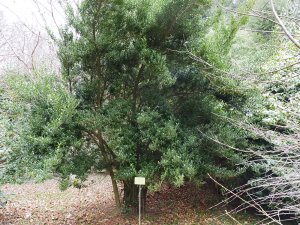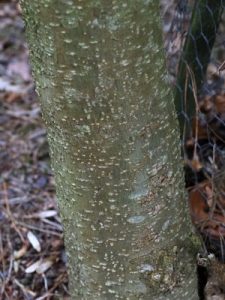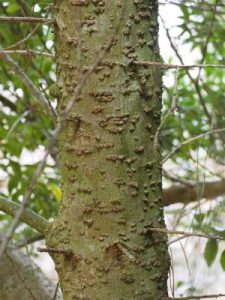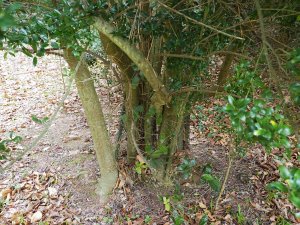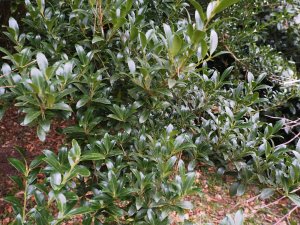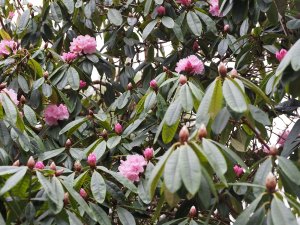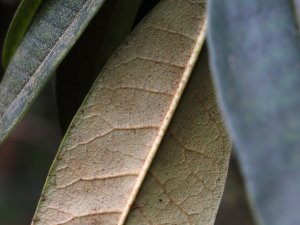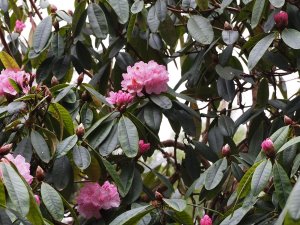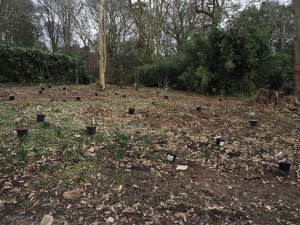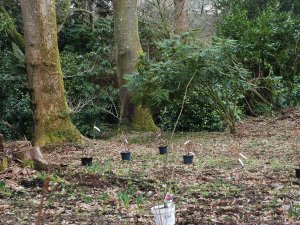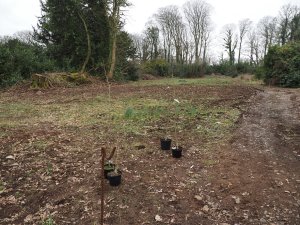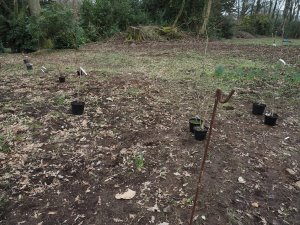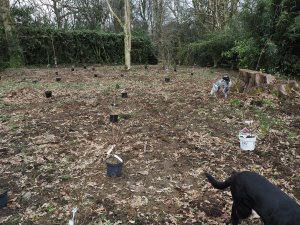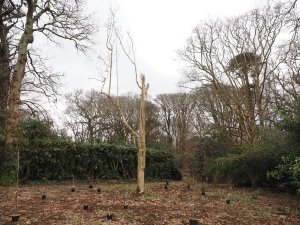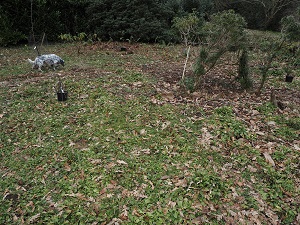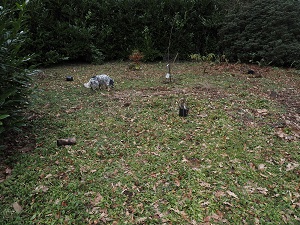2025 – CHW
Very first flower out on Camellia x williamsii ‘Lady’s Maid’.
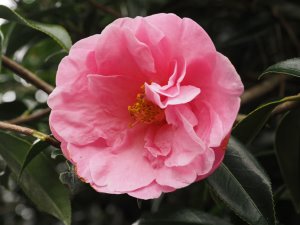
Surprisingly Camellia japonica ‘Mrs D. W. Davis’ is well out high up much earlier than usual.
Camellia ‘Fairy Blush’ and Camellia reticulata – Garden form – looking good together today.
Fist flowers now showing on Magnolia ‘Bishop Peter’. Always early and sometimes ahead of the other magnolias we have already seen in flower.
Camellia ‘Salutation’ (C. reticulata x C. saluenensis) was raised at Borde Hill and is not be muddled with Camellia x williamsii ‘Delia Williams’ which has a quite different flower.
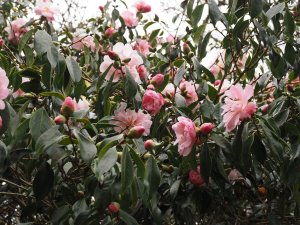
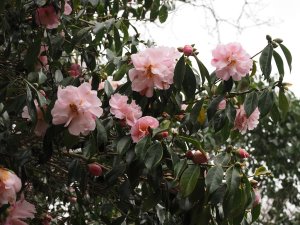
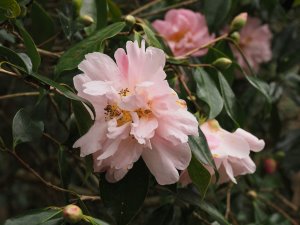
Sadly Rehderodendron indochinense (BSWJ 12115) has suddenly died, for no obvious reason, about 10 years after planting.
Odd flowers out low down on the best 1913 planted Magnolia campbellii blown open in the east wind.
2024 – CHW
Another foul wet day (rain from 9am through to midnight) where we try to do some planting but eventually give up.Nevertheless in the last 3 warm and wet days the magnolia season is upon us in earnest. Come soon now or you may well miss the best of them.The Magnolia ‘Lanarth’ outside the Georgian Hall has more flowers than usual but they have been blown open prematurely and are a poor colour.
Another foul wet day (rain from 9am through to midnight) where we try to do some planting but eventually give up.Nevertheless in the last 3 warm and wet days the magnolia season is upon us in earnest. Come soon now or you may well miss the best of them.The Magnolia ‘Lanarth’ outside the Georgian Hall has more flowers than usual but they have been blown open prematurely and are a poor colour.
Tepals falling already under the original Magnolia campbellii.
Jaimie’s Rhododendron ‘Maisie’ just out.
Magnolia campbellii ‘Darjeeling’ had no hint of colour just 3 days ago.
Another group clump of Rhododendron ririei opens up.
Magnolai ‘Bishop Peter’ is full out.
Flowers on Rehderodendron indochinense
The New Zealand form of Magnolia ‘Lanarth’.
Beside it a near white Magnolia campbellii ‘Alba’ seedling.
Magnolia sprengeri ‘Dusty Pink’ near Tin Garden.
Magnolia ‘Princess Margaret’.
The Magnolia campbellii above Crinodendron Hedge perfect in the gloom and rain.
Rhododendron ‘Cornish Red’ racing out by the lawn.
2023 – CHW
Cold north wind to hold the magnolias back again – no harm in that.
More rhododendrons looking sick. Here a clump of 3 Rhododendron ‘Saffron Queen’ with one on the way out following the drought.
Our new 2021 clump of 10 Rhododendron viscosum below 4-in-Hands has also seen 6 of the plants in the fullest sun succumb to the summer heat.
A good clump of early daffodils on Bond Street.
Our best clump of snowdrops is on Bond Street but these are nearly over after 3½ weeks in flower.
Early new growth and only minor die back (as yet) on Hypericum lancasteri.
Another windblown branch from Acacia cultriformis on the bonfire pile.
Daphne bholua ‘Mary Rose’ has small flowers this year and not as dark a colour as usual.
Rhododendron campylogynum in the Rockery is two thirds dead from the drought and the other third is on its last legs. This species live on 20-30 years here.
2022 – CHW
To Cheshire and Manley Cottage for Lizzie’s mum’s memorial service in Tarporley.
The garden at Manley Cottage was springing into life.
Chaenomales x superba ‘Nicoline’
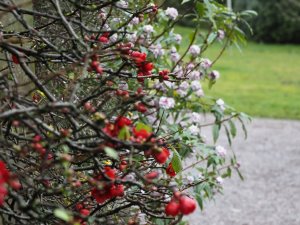
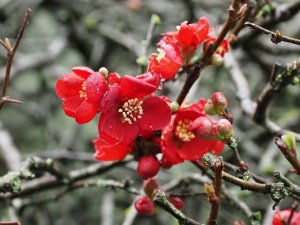
Daphne bholua ‘Jacqueline Postill’ full out with plenty of root suckers appearing.
Daphne bholua ‘Jacqueline Postill’ and Jasminum nudiflorum.
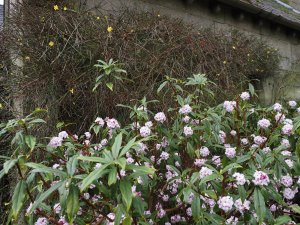
Kerria japonica ‘Pleniflora’
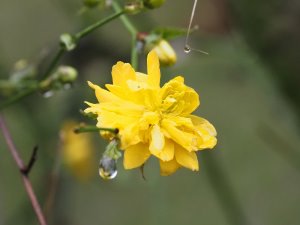
Amazingly Leujocum aestivum were already out. Ours are hardly out of the ground yet in Tin Garden.
A pale form of Rhododendron mucronulatum with leaves also appearing. Perhaps three to four weeks behind our plants at home.
Rhododendron ‘Christmas Cheer’ just out.
White violets out in numbers too.
And plenty of cyclamen.
Quercus wizlizeni as a mature evergreen tree. Interesting bark.
The dwarf Rhododendron sargentianum just starting.
While Rhododendron cilpinense still in bud.
I think this is Hamamelis x intermedia ‘Arnold Promise’ but may be wrong and it is similar to Hamamelis ‘Brevipetala’. It looks faintly orange from a distance but the short flowers are yellow close to. A very ancient plant with props to keep it in place. Wonderful scent and quite late on in February for a hamamelis to still be full out. ‘Arnold Promise’ is late into flower the reference books say.
Manley Cottage on a bleak day.
Chaenomales x superba ‘Nicoline’ and Daphne bholua ‘Jacqueline Postill’.
Hamamelis x intermedia ‘Diane’.
Campanula still in flower after a mild winter.
Pieris japonica ‘Taiwanensis Group’ in flower here and there on this small bush.
Camellia x williamsii ‘Bow Bells’ with a few flowers. Drooping habit. Not that exciting but the only camellia I could find out today at Manley Cottage.
2021 – CHW
To Burncoose to start this year’s garden planting.
This young and rare Carpinus has been totally ringbarked by squirrels from top to bottom.
Ilex mutchagara (perhaps Ilex mitis var. mutchagara) is a UK and Ireland record tree in Burncoose Garden. I wanted more close up pictures of the leaves, bark and trunk for my ilex article. It is clearly a suckering species with interesting knobbly bark. Widespread in Africa this one must have come from a colder location as it is untouched by last week’s Beast.
Flowers on a Rhododendron arboreum hybrid.
Styrax japonicus is quickly a suckering clump if the roots get to the surface.
As large an area of new planting as we have had at Burncoose for many years after the east wind last spring felled two huge mature beech and one younger one. We then cleared all the laurel up to the old walled garden and will replant a new laurel wind protection hedge further back. The two beech stumps were too much for the digger and remain in situ to rot away. There will be honey fungus in the area so we have not planted many rhododendrons. Some lilacs, Philadelphus and Deutzia to give summer colour. Magnolia ‘Caerhays Splendour’ is the centrepiece with Magnolia ‘Raspberry Fun’, Magnolia ‘Antje Zandee’, Magnolia ‘Blue Opal’ and Magnolia ‘Mighty Mouse’ included as well. A new kalmia planting too as the tennis court plants are showing their age. A mixture of rarities and colour for visitors. The other half of the clearing cannot be planted until the tree surgeon finally removes the dying turkey oak which threatens to hit the record sized Magnolia sargentiana var. robusta as you can see here.
A bit of pollarding needed on the Magnolia mollicomata hit by the beech trees.
We also started away six different Pseudopanax varieties across the path where there used to be an old nursery bed. The objective, in 10 years or so, is to grow enough of this genus to apply for national collection status. There are three species in the garden already.
Our first consignment of liner plants from France since Brexit has arrived safely. The paperwork and certification cost around £360. So much for the ‘free trade’ deal but at least there were no tariffs.
Our first consignment of liner plants from France since Brexit has arrived safely. The paperwork and certification cost around £360. So much for the ‘free trade’ deal but at least there were no tariffs.
In the cold the specimen cycads have been having artificial light as well as heat.




